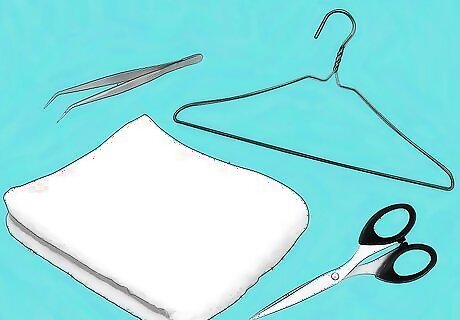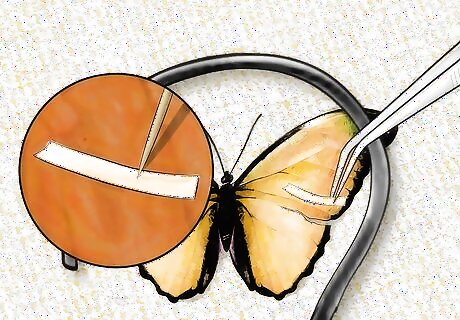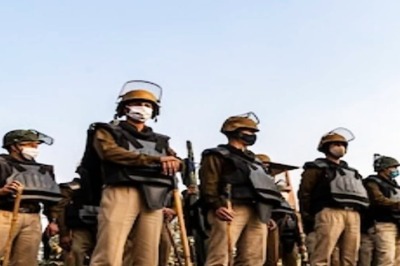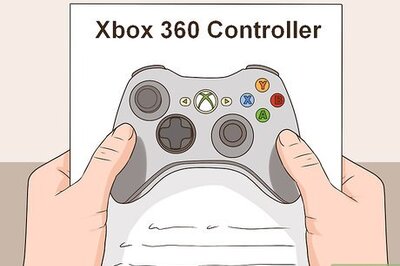
views
- Set the butterfly in a jar with air holes and place it in the fridge for 10 minutes. If less than ⅓ of the wing is damaged, cut the other wing to make them match.
- Or, lay the butterfly on a table with the legs facing down. Anchor its wings in place with the hook of a hanger.
- Then, cut out a piece of cardstock long enough to span the wing’s break. Apply contact glue on the paper and wing and then press on the paper.
Fixing the Wing

Grasp the butterfly. Before touching the butterfly, make sure your hands are clean and dry. With the wings closed, grab the butterfly by the wings just above the body. You don't need to hold it very hard, just tight enough to keep it from wriggling free. Contrary to popular belief, you won't harm the butterfly simply by touching it. A butterfly can lose some scales and still fly just fine. The real hazard comes from the fact that the wings are very thin and delicate. Holding it upside down can calm it down.

Place the butterfly in the refrigerator. While this step may seem cruel, it can calm the butterfly enough so that you can work on it. You're not trying to kill the butterfly. You're just trying to sedate it a bit. Stick it in a smooth container. A glass works well for this step. You may need to partially cover it if the butterfly is still able to flutter. However, make sure to leave room for air flow. Don't leave the butterfly in the refrigerator for longer than 10 minutes, as it could eventually kill the butterfly.

Get your supplies ready. You'll need a towel, as well as a wire clothing hanger. You'll also need tape or contact adhesive (found at auto part stores), scissors, and maybe tweezers. Toothpicks, cotton swabs, baby powder, and lightweight card stock (the kind that has different colors on each side is best) can also be helpful. You may also need extra butterfly wings if the butterfly is missing much of its wing. You can find broken pieces in places where butterflies congregate, or you can use a wing from a dead butterfly. The contact adhesive is the type that you paint on both surfaces. You then give it a chance to dry before pushing it together. Bend the hook on the wire clothing hanger. It should form a loop that will just fit over the butterfly's main body (not the wings).

Cut to make wings even. One way to do a minor repair is to simply cut the butterfly's wings to make them even. They need to be even for the butterfly to fly, so cutting them to be even can work if one wing only has minor damage. Grasp the butterfly just above the body with the wings closed. Cut the undamaged wing to match the damaged wing. Only use this method if less than 1/3 of the wing is missing. The butterfly is not hurt when you cut the wing. It's like getting a haircut. This option is also a good one if you're not willing to repair the wing with glue or splints. In other words, taking off damaged wings, even both of them, can help the butterfly more than just leaving it with damaged wings. It may not be able to fly, but it may still be able to lay eggs.

Immobilize the butterfly for more severe damage. Lay out a towel on a table. Place the butterfly flat on the table with its legs facing down. Place the loop of the clothes hanger over the butterfly. It should go around the body, but press down lightly on the wings. You can even lightly weigh down the other end of the hanger to hold it in place. Keep the lighting dim, as that can help calm the butterfly. You can also use tweezers to press down around the butterfly's body, holding it down. However, that only gives you one hand to work with. Extend the wings by grasping one edge and pulling out gently.

Prepare a splint for a bent wing. Cut a tiny piece of card stock. It only needs to be a few millimeters wide. For length, it needs to be long enough to go across the break in the wing (once you line it up), but that's it. In other words, you need a very small piece of card stock. Use a toothpick to add glue to one side of the card stock. Also, paint a small line of contact adhesive across the bend in the wing. Take off any extra adhesive. Let both sets of glue dry. Note that contact adhesive is not just regular glue. It is a special type of adhesive that sticks to itself when dry. Line up the wing perfectly. Press the card stock, glue-side down, across the crack. It's easiest to use tweezers for this step. After a moment, release the butterfly. Gently lift the butterfly's wing from the towel if the glue stuck it down. Also, sprinkle a light dusting of baby powder over the glued area so it doesn't stick to the other wing as the final step of this repair. You can use a cotton swab to help spread the powder out. Another option for a torn wing is simply a piece of scotch or duct tape. Once you immobilize the butterfly, use a small piece of tape across the bend or tear. However, this method won't provide as much structure as the small splint.

Replace a significantly damaged wing. If the wing is missing a significant part or is badly damaged, you can either reattach the missing part or put on a new wing. Start by cutting off the wing if it is badly damaged, leaving some at the bottom as a place to attach a new wing. Make sure the butterfly is laid out on the towel for this whole step. Line up the wing. Whether you are adding a new wing or using a part of the wing that has fallen off, it's important to line it up as close as you can to the old veins. If you are adding a new wing, try to pick one as close in size to the other wing as possible. Trim it so only a small bit overlaps. Add glue. Use a toothpick to apply contact adhesive to both edges off the wing, the parts that will slightly overlap and stick together. Take off any extra adhesive, and let it dry. While it dries, make sure to keep the butterfly immobilized, as you don't want it to glue its wings together. Once the glue dries, press the two edges of the wing together. You can add a small strip of card stock with the same gluing technique to help bridge the gap. Once you've glued everything in place, sprinkle baby powder over the glued area to keep it from sticking to the other wing. Check for any mistakes before releasing the butterfly. For instance, make sure the other wing doesn't stick to the glue. Also, make sure all parts are moving.
Feeding the Butterfly

Research your particular butterfly. Different butterflies have different needs. Some butterflies do not eat at all as adults. These butterflies only eat as caterpillars. However, most do eat some type of food, usually nectar that you can substitute a sugary solution for. Try using a butterfly book or an online database of butterflies to find your butterfly, which will have more information about what the butterfly eats. In addition, if you find the specific butterfly you have in captivity, you can learn what kind of flowers they usually visit. That way, you can provide them with those flowers instead of a sugar solution. Monarchs, for instance, often visit milkweed flowers, among others.

Provide a food source. Since your butterfly had a damaged wing, it hasn't been able to get to food very well. Therefore, it may be pretty weak once you finish. Providing a food source gives the butterfly the energy it needs to move onward. One solution is to find flowers that your butterfly normally eats. Use your research to find wildflowers in your area for your butterfly. Set them near your butterfly, then set the butterfly on the flower so it can drink the nectar.

Create "nectar." You can create a nectar substitute for your butterfly with things you have in your pantry. This solution will be enough to get the butterfly going again, letting it find it's own food source. In a small cup, add about half a cup of room temperature water. Add a tablespoon of sugar. Stir until the sugar dissolves. If it doesn't dissolve, you can heat up the water to help it dissolve. Just make sure it cools before you give it to your butterfly. Don't add any coloring to the mixture. Add paper towel wicks. Roll up a 5-inch-by-7-inch piece of paper towel. Put one end in the water, and drape the other end over the edge of a the cup. This wick will bring the solution up to the edge of the cup, making it easier for your butter fly to drink. Set your butterfly on the edge of the cup at the wick so it can drink. Some butterflies, especially male butterflies, can eat fresh fruit such as peaches, plums, cherries, or oranges. Break the fruit open so that the butterfly can get to the flesh.

Release the butterfly. Hold out your hand so the butterfly crawls onto your finger. If it won't crawl up, grasp it with the wings closed just above the body. You can let the butterfly loose as soon as it has regained its strength with some sugar water or nectar. You don't need to wait for it to "heal." Let the butterfly sit on your finger for a minute. Take it outside. Let it sit on your finger until it is ready to fly away. The butterfly will gather warmth from your body before moving on, which is important if you chilled it. It needs to be at least 55 °F (13 °C) outside for the butterfly to survive.




















Comments
0 comment